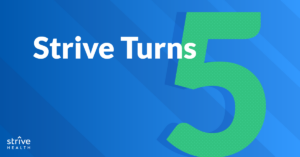How Advances in Health Tech Are Saving Lives and Transforming Care for Chronically Ill Patients
Author : Strive HealthBy Masoud Nourmohammadi, Chief Technology Officer, Strive Health
I admit it. I’m passionate about healthcare technology. I’ve spent my career building robust products that unleash the power of data to improve patient care and clinical outcomes. I love being a Chief Technology Officer because it allows me to identify the problems and obstacles standing in the way and find a solution to overcome them. A good CTO is someone who is ready to walk into chaos with open arms and not quit until an improved methodology presents itself.
Maybe it’s my family’s background in medicine that helped guide me to what I do today. I was raised in a family of clinicians. My mom is a nurse, and my uncles are physicians. My father passed away a few years back due to undiagnosed chronic disease, so the notion of using the insights produced by data to solve clinical challenges is something I think about a lot. It’s a frequent topic at family gatherings.
What’s as important as the data are the teams developing and managing that data. In my role as CTO at Strive Health, a leading value-based kidney care company, I’m responsible for building a highly-scalable technology ecosystem that enhances the patient experience while allowing clinicians to do what they do best. Our data science team collects crucial data points across markets so we can get a complete population health view. Then, we build custom technology solutions that use modern product development concepts to help an often slow-to-adopt healthcare industry move more quickly.
My product management team works with a clinical team of nurse practitioners, care coordinators, medical assistants, clinical social workers and dietitians to make sure they can spend most of their time on patient care instead of on administrative tasks.
We developed a health tech platform powered by machine learning algorithms that can examine and analyze massive amounts of data, cut through the noise and allow clinicians to focus on doing what only they can do — high-touch patient care. As a result, we have seen drastic reductions in unplanned dialysis starts (“crashes”) and hospitalizations, and higher adoption of home dialysis.
My team shares my passion for problem solving, so in our collaborations with health systems and payors, we encourage them to bring us their problems. Whether the problem involves patient data collection, an interface issue or some other challenge, we’re all in the business of saving lives by providing the right care at the right time. My mission is to find technology-enabled solutions, regardless of scale.
A good example of this is when a patient who was self-isolating during the Covid-19 pandemic had to be admitted to the ER. Our real-time monitoring system instantly alerted us, so our clinical team could proactively intervene, potentially saving this patient’s life.
Here’s another example. A lot of kidney patients are aging. The CDC estimates that about 15% of U.S. adults, including 38% of those over 65, suffer from kidney disease. Many kidney disease patients live in rural areas, making it difficult for them to access appropriate care. It’s not about their willingness to use technology in order to connect with a clinician. It’s literally a lack of access. So, we successfully piloted a program that sent tablets to these patients, allowing them to sign in with the click of a button and access video appointments with a clinician.
One of healthcare’s biggest challenges is that healthcare data, on the whole, is very messy and incomplete. That makes it hard to compare patients in one region of the country with another. It makes getting a “complete view” nearly impossible. Nearly.
By creating a universal disease stage logic, which employs machine learning to fill in the gaps, we are able to accurately compare patients, regardless of the quality of data we receive at intake. That kind of solution is only possible with a centralized product team. As a product developer, you have to be able to understand the problem and acknowledge the fact that in no way are we trying to replace a clinician’s judgment. Instead, we can operate in the background to present the data in a new way that makes more sense.
Using machine learning models helps us create apples-to-apples comparisons of patients and their kidney disease progression. We gather data from hundreds of sources, enabling a holistic patient view through the implementation of predictive analytics that are specific to each market and partner. By training our machine learning models on over 53 million patient records, we provide clinicians with actionable insights like risk scores, end-stage crash predictions and artificial intelligence algorithms that identify patients whose kidney disease is undiagnosed.
There is an incredible future for organizations that prioritize innovation. Working together, product development and data teams can help clinicians to focus on ways to deliver that bright future through value-based care models and paradigm-shifting technology like machine learning and AI.
The future calls for, nay, requires, the marrying of the old with the new, and healthcare companies that want to survive have to get on board.
Masoud Nourmohammadi is Chief Technology Officer at Strive Health, managing a fast-growing team of skilled software developers. Masoud, attracted to Strive because of the opportunity to build a new model from the ground up, is building an analytics, dispatch, and decision-making hub that will improve patient lives every day. Masoud is passionate about building great technology, but even more so, is passionate about building world-class, innovative technology teams.
Masoud began his career as a Senior Software Engineer at Mountain Medical Physicians Specialists in 2005, rising to serve as Chief Technology Officer in 2014. In this role, he gained first-hand experience working with physicians, nurses, and caregivers to deliver best-in-class software solutions. He then moved to Health Catalyst, where he served as Vice President of Engineering, building the largest healthcare data repository in the world, often called the Google of Healthcare.








